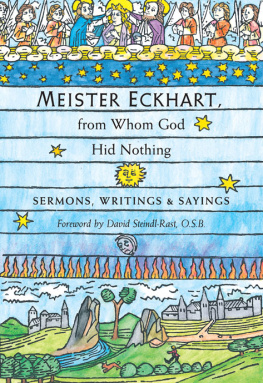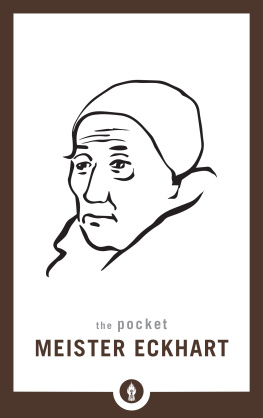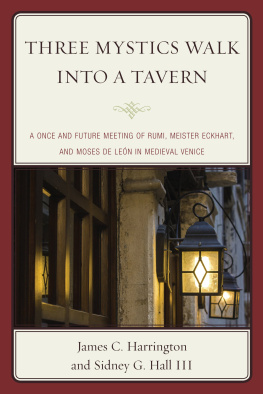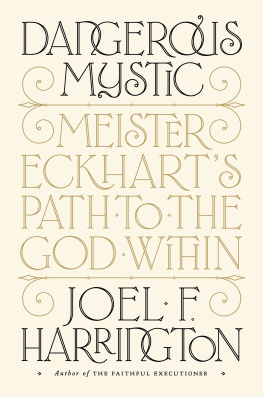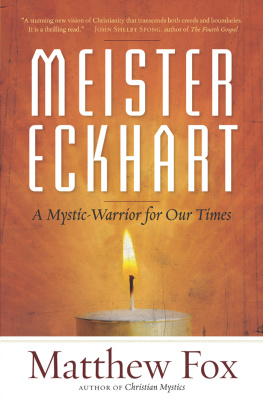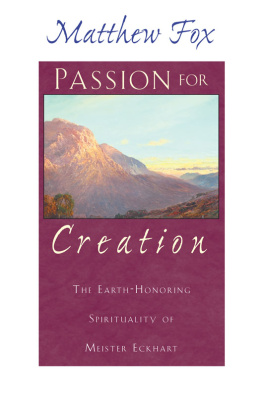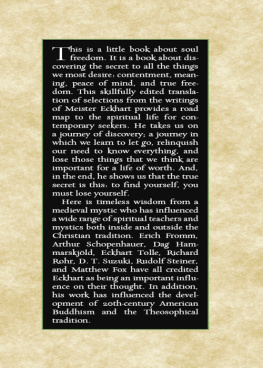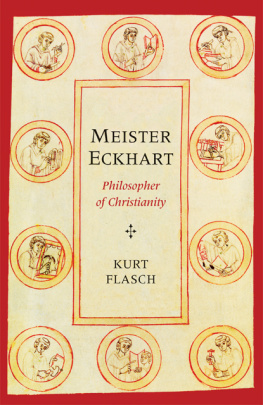Even though the Roman Catholic Church tried hard to suppress its German Dominican priest, Meister Eckhart, by excommunication and condemnation, his writings have remained influential. Eckhart has been especially important among those seeking ways to connect Eastern religious traditions to Christian ones. The problem is that Eckharts writing is difficult reading, losing much in translation not only from German to English but also from the 13th to the 20th century. ONeal has produced an exceptional introductory edition that makes Eckhart more accessible. ONeals edition is an important introduction to Eckharts work in that it draws the best texts from the most successful translations and, from them, produces a rich tapestry of presentation for this often quoted and little understood Rhineland mystic.
Publishers Weekly
That Meister Eckhart is among the most important of Christian mystics is beyond dispute, so any collection that makes his work accessible to a wider audience is welcome. This new collection assembles material from existing translations along with a foreword by an important contemporary Benedictine mystic. The material is organized with an eye toward easing readers into Eckhart, beginning with short quotations then moving to table talk, sermons, and other longer pieces.
Steve Schroeder, Booklist
ABOUT THE BOOK
This introduction to the writing and preaching of the greatest medieval European mystic contains selections from his sermons, treatises, and sayings, as well as Table Talk, the records of his informal advice to his spiritual children.
MEISTER ECKHART (12601327) was a German Dominican theologian and popular preacher who believed that God is best approached through paradox and mystery rather than through reason or logic. His works have rung true with seekers for more than eight hundred years.
Sign up to learn more about our books and receive special offers from Shambhala Publications.

Or visit us online to sign up at shambhala.com/eshambhala.


For my mother, Darlene ONeal
New Seeds Books
An imprint of Shambhala Publications, Inc.
Horticultural Hall
300 Massachusetts Avenue
Boston, Massachusetts 02115
www.newseeds-books.com
1996 by David ONeal
Foreword 1996 by David Steindl-Rast, O.S.B.
Cover art: The Seven Spheres of Heaven, from a fifteenth-century German woodcut.
Color version by Jennifer Devine.
All rights reserved. No part of this book may be reproduced in any form or by any means, electronic or mechanical, including photocopying, recording, or by any information storage and retrieval system, without permission in writing from the publisher.
Library of Congress Cataloging-in-Publication Data
Eckhart, Meister, d. 1327.
[Selections. English. 2005]
Meister Eckhart, from whom God hid nothing:
sermons, writings, and sayings/edited by David ONeal;
foreword by David SteindlRast.1st New Seeds ed.
p. cm.
eISBN 978-0-8348-2639-7
ISBN 1-59030-279-6 (pbk.: alk. paper)
1. MysticismCatholic ChurchMiscellanea. 2. Spiritual LifeCatholic ChurchMiscellanea. 3. Catholic ChurchDoctrinesMiscellanea. I. ONeal, David, 1954 II. Title.
BV5080.E3213 2005b
248.22dc22
2005047988
His Holiness the Fourteenth Dalai Lama feels quite at home in the world of Meister Eckhart, and His Holiness Pope John Paul II quotes the same Meister Eckhart on occasion in a sermon. Now, theres a bridge builder between traditions! Should this come as a surprise? No, it shouldnt surprise us, for Meister Eckhart is a mystic. The mystics of all traditions speak one and the same language, the language of religious experience.
When I use the term religious experience, I mean something that is not at all the private domain of those whom history has called the mystics in a special sense; rather, I mean something familiar to you and me and to everyone likely to read this book. Religious experience is simply our awareness of communion with the Ultimate. (Meister Eckhart calls the Ultimate God, but those who feel less comfortable with that word are certainly not barred for that reason from experiencing the reality to which the word God points.)
Communion with the Ultimate may surprise and overwhelm us unawares in peak moments of alivenesson horseback, on a mountaintop, on the prow of a ship, under the dome of the night sky, or in a lovers arms. Or it may happen that we experience the same communion with the Ultimate as slowly, slowly dawning on us during a long-drawn-out struggle to remain faithful to ourselves, during a painful process of grieving, or during seemingly endless nights at the bedside of a dying friend. What counts is that it happens, not how. What counts is that we somehow experience a limitless belonging to that unspeakable mystery which alone ultimately matters.
For some, this experience lasts barely longer than the glimpse of a falling star, seen and forgotten; forgotten, or suppressed among a thousand preoccupations with other matters. We had the experience, but missed the meaning, as T. S. Eliot puts it. For a moment we touched a live spark, but we did not fan it into fire, we let it go out. Not so those whom we call the great mystics. They spend their lives on what all of us, in our best moments, long for. The poet Rilke expresses this longing in a glowing prayer (as translated by Steven Mitchell):
O shooting star
that fell into my eyes and through my body:
Not to forget you. To endure.
The flash of religious experience challenges us to three all-demanding tasks: embodiment, remembrance, endurance. Those brave ones who rise to this challenge endure the blinding vision, remember it in whatever they do, and so embody vision in action. By this process, mysticism becomes a way of life. It may even become the starting point for a religious tradition.
All the different religions can be traced back to an experience of communion with the Ultimate by their founders or reformers. Historic circumstances lead then to the great diversity of religious traditions. Yet all those diversities are only so many expressions of one and the same mystical coreexpressions of the sense of ultimate belonging. This mystical core needs to bring forth so many different myths and teachings, needs to be celebrated in so many different rituals, because it is inexhaustible.
Not only is the mystical core of religion inexhaustible, it is also ultimately unspeakable. The heart of all ritual is stillness; the heart of all teaching is silence. The mystics of every tradition know this and keep telling us that those who speak do not know, and those who know do not speak. Yet those same mystics write volumes and volumes. Meister Eckhart is no exception. The language of mystics, however, explodes ordinary language. What is left, after that, is silence, a silence that unites.
Language is meant to build bridges. Yet how often language divides. It divides when we get stuck in concepts and abstractions, alienated from experience. It is a dreadful thing when this happens to religious language, yet it tends to happen in every tradition. This is why we need the language of mystics to blow to pieces the conceptual walls that divide uslong enough for us to get in touch again with that silent ground of our unity in experience. Once we are grounded in silence, conceptual thinking, too, will regain its proper function. No longer will concepts be the bars of a mental prison, but rather the bars of a musical scorefor a music of silence.
Next page
